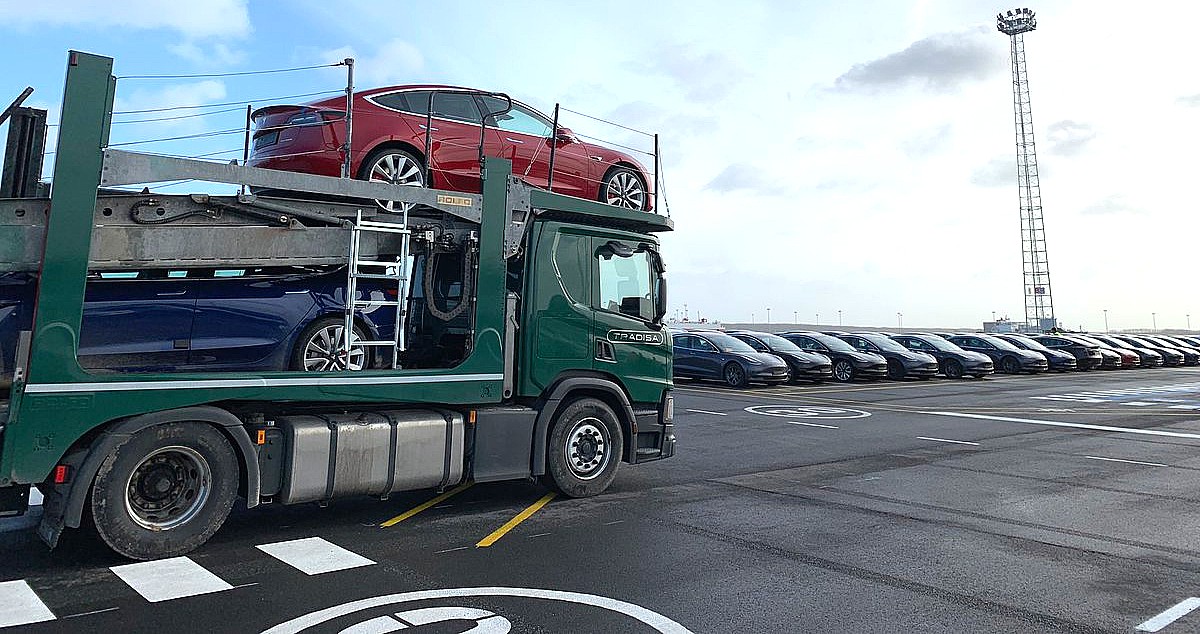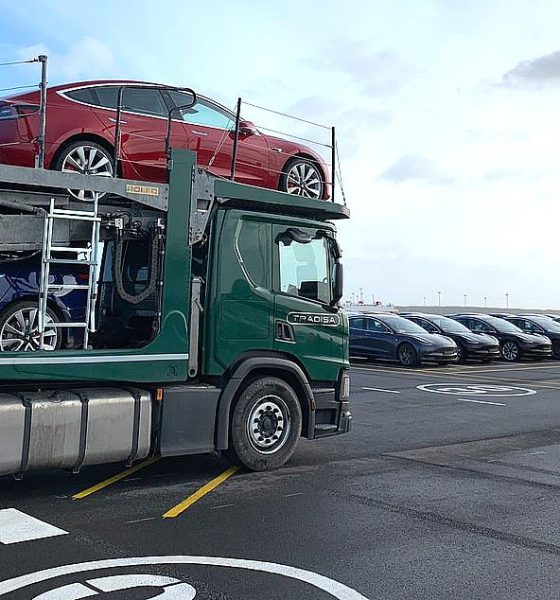

Investor's Corner
Tesla Model 3 tsunami pushes Norway’s electric car sales to record levels
An announcement from the Norwegian Road Federation (NRF) has revealed that nearly 60% of all vehicles sold in Norway last month were all-electric, setting a new record for EV sales in the country. Behind this historic milestone is the arrival of a sedan that was designed to disrupt the auto industry: the Tesla Model 3.
Norway registered 10,316 electric vehicles in March, comprising 58.4% of all car sales in the month. This was the first time that EVs accounted for more than 50% of all auto sales in the country. The market share of all-electric cars in the first quarter was also the highest recorded at 48.4%.
What is rather remarkable about Norway’s EV sales record was that it was largely driven by the Tesla Model 3, which set a new benchmark for competing electric car makers by selling 5,315 vehicles in March. That’s far above the previous record held by the Nissan Leaf, which sold 2,172 units in one month last year.
More than 18,000 cars were registered in Norway on March, over 10,000 of which were electric vehicles. From this number, 5,822 were Tesla Model S, Model 3, and Model X. This means that in March, Tesla accounted for over 31% of Norway’s car sales, or one in every three vehicles. For a 15-year-old carmaker, such a feat is incredibly impressive.
Granted, Norway is but a small country, and its sales will likely pale in comparison to the numbers that will be produced by territories like China. Nevertheless, Tesla’s Model 3-driven milestone carries a lot of significance, as it all but proves that demand for the electric sedan is significant in territories beyond the United States.
Among the most prominent bear thesis against Tesla this first quarter was the assumption that demand for its vehicles has weakened significantly. Last week alone, RBC analyst Joseph Spak reduced his price target on Tesla stock (NASDAQ:TSLA) by $35 to $210 over what be cited as “meager demand” for the Model 3. Norway’s March figures are a direct rebuttal of this assumption, as it shows that it is far too early to discount the demand for the Model 3, at least until the vehicle gets a chance to compete in the international market.
Norway’s EV sales records in March also proved that it is possible to quickly and aggressively adopt electric transportation. Secretary-General Christina Bu of the Norwegian EV Association highlighted this point in a statement to news agency Elbil.no.
“Norway has every reason to be proud of breaking more BEV records. The BEV policy is working so well that the larger part of consumers opts for a BEV when buying a new car. Norway shows the whole world that fully electric cars can replace petrol and diesel cars and become an important contribution to combat CO2 emissions, as well as relieving local air from other harmful gases caused by burning fossil fuels,” Bu said.
Norway’s milestone is a victory for Tesla, whose parimary mission as frequently noted by Elon Musk is to accelerate the transition of the world to sustainable energy. Encouraging the transportation sector to adopt electric cars is a valuable component of this goal, and with Norway’s March sales numbers, the country and the carmaker have proved such a goal is not too far-fetched. All it takes is open support for EVs and an electric car that is better than its gasoline counterparts in every way.

Investor's Corner
Tesla stock closes at all-time high on heels of Robotaxi progress

Tesla stock (NASDAQ: TSLA) closed at an all-time high on Tuesday, jumping over 3 percent during the day and finishing at $489.88.
The price beats the previous record close, which was $479.86.
Shares have had a crazy year, dipping more than 40 percent from the start of the year. The stock then started to recover once again around late April, when its price started to climb back up from the low $200 level.
This week, Tesla started to climb toward its highest levels ever, as it was revealed on Sunday that the company was testing driverless Robotaxis in Austin. The spike in value pushed the company’s valuation to $1.63 trillion.
Tesla Robotaxi goes driverless as Musk confirms Safety Monitor removal testing
It is the seventh-most valuable company on the market currently, trailing Nvidia, Apple, Alphabet (Google), Microsoft, Amazon, and Meta.
Shares closed up $14.57 today, up over 3 percent.
The stock has gone through a lot this year, as previously mentioned. Shares tumbled in Q1 due to CEO Elon Musk’s involvement with the Department of Government Efficiency (DOGE), which pulled his attention away from his companies and left a major overhang on their valuations.
However, things started to rebound halfway through the year, and as the government started to phase out the $7,500 tax credit, demand spiked as consumers tried to take advantage of it.
Q3 deliveries were the highest in company history, and Tesla responded to the loss of the tax credit with the launch of the Model 3 and Model Y Standard.
Additionally, analysts have announced high expectations this week for the company on Wall Street as Robotaxi continues to be the focus. With autonomy within Tesla’s sights, things are moving in the direction of Robotaxi being a major catalyst for growth on the Street in the coming year.
Elon Musk
Tesla needs to come through on this one Robotaxi metric, analyst says
“We think the key focus from here will be how fast Tesla can scale driverless operations (including if Tesla’s approach to software/hardware allows it to scale significantly faster than competitors, as the company has argued), and on profitability.”

Tesla needs to come through on this one Robotaxi metric, Mark Delaney of Goldman Sachs says.
Tesla is in the process of rolling out its Robotaxi platform to areas outside of Austin and the California Bay Area. It has plans to launch in five additional cities, including Houston, Dallas, Miami, Las Vegas, and Phoenix.
However, the company’s expansion is not what the focus needs to be, according to Delaney. It’s the speed of deployment.
The analyst said:
“We think the key focus from here will be how fast Tesla can scale driverless operations (including if Tesla’s approach to software/hardware allows it to scale significantly faster than competitors, as the company has argued), and on profitability.”
Profitability will come as the Robotaxi fleet expands. Making that money will be dependent on when Tesla can initiate rides in more areas, giving more customers access to the program.
There are some additional things that the company needs to make happen ahead of the major Robotaxi expansion, one of those things is launching driverless rides in Austin, the first city in which it launched the program.
This week, Tesla started testing driverless Robotaxi rides in Austin, as two different Model Y units were spotted with no occupants, a huge step in the company’s plans for the ride-sharing platform.
Tesla Robotaxi goes driverless as Musk confirms Safety Monitor removal testing
CEO Elon Musk has been hoping to remove Safety Monitors from Robotaxis in Austin for several months, first mentioning the plan to have them out by the end of 2025 in September. He confirmed on Sunday that Tesla had officially removed vehicle occupants and started testing truly unsupervised rides.
Although Safety Monitors in Austin have been sitting in the passenger’s seat, they have still had the ability to override things in case of an emergency. After all, the ultimate goal was safety and avoiding any accidents or injuries.
Goldman Sachs reiterated its ‘Neutral’ rating and its $400 price target. Delaney said, “Tesla is making progress with its autonomous technology,” and recent developments make it evident that this is true.
Investor's Corner
Tesla gets bold Robotaxi prediction from Wall Street firm
Last week, Andrew Percoco took over Tesla analysis for Morgan Stanley from Adam Jonas, who covered the stock for years. Percoco seems to be less optimistic and bullish on Tesla shares, while still being fair and balanced in his analysis.

Tesla (NASDAQ: TSLA) received a bold Robotaxi prediction from Morgan Stanley, which anticipates a dramatic increase in the size of the company’s autonomous ride-hailing suite in the coming years.
Last week, Andrew Percoco took over Tesla analysis for Morgan Stanley from Adam Jonas, who covered the stock for years. Percoco seems to be less optimistic and bullish on Tesla shares, while still being fair and balanced in his analysis.
Percoco dug into the Robotaxi fleet and its expansion in the coming years in his latest note, released on Tuesday. The firm expects Tesla to increase the Robotaxi fleet size to 1,000 vehicles in 2026. However, that’s small-scale compared to what they expect from Tesla in a decade.
Tesla expands Robotaxi app access once again, this time on a global scale
By 2035, Morgan Stanley believes there will be one million Robotaxis on the road across multiple cities, a major jump and a considerable fleet size. We assume this means the fleet of vehicles Tesla will operate internally, and not including passenger-owned vehicles that could be added through software updates.
He also listed three specific catalysts that investors should pay attention to, as these will represent the company being on track to achieve its Robotaxi dreams:
- Opening Robotaxi to the public without a Safety Monitor. Timing is unclear, but it appears that Tesla is getting closer by the day.
- Improvement in safety metrics without the Safety Monitor. Tesla’s ability to improve its safety metrics as it scales miles driven without the Safety Monitor is imperative as it looks to scale in new states and cities in 2026.
- Cybercab start of production, targeted for April 2026. Tesla’s Cybercab is a purpose-built vehicle (no steering wheel or pedals, only two seats) that is expected to be produced through its state-of-the-art unboxed manufacturing process, offering further cost reductions and thus accelerating adoption over time.
Robotaxi stands to be one of Tesla’s most significant revenue contributors, especially as the company plans to continue expanding its ride-hailing service across the world in the coming years.
Its current deployment strategy is controlled and conservative to avoid any drastic and potentially program-ruining incidents.
So far, the program, which is active in Austin and the California Bay Area, has been widely successful.








